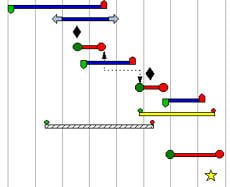Project Management
This post will look at an aspect of managing projects that is often overlooked. These are the steps you need to take prior to project commencement. The idea for this came from a presentation by Graeme Joy to the Casey Cardinia Business Group covering his expedition to the North Pole.
Planning a Project
The thing that stood out the most from his presentation was how much of the project depended on the up front planning, and how little they could do to influence the final outcome once they set foot onto the ice.
So how did they do it?
Pick the right team
If you want a High Performance Team, then every member needs to be able to carry their weight and to be able to continue to do so during the whole of the project and in cooperation with the rest of the team members. So friction is OK as long as it leads to a good outcome. In fact you need divergent view points to prevent group think settling in.
So how do you pick the team members?
Step one is that a High Performance Team needs a High Performance Leader or leadership group. The High Performance Leader has to be able to set the scene for the purpose the team exists for and also gain commitment from the team members toward that purpose. The steps include:
- Vision – Create and Develop commitment within your team. Defining success and the measurement of performance.
- Empowerment – creating leaders within your organisation.
- Urgency – A Sense of Urgency is critical
- Communicate – You have to be an excellent communicator
- Attitude – a positive attitude is more important than skill
- Empathy – understand who your team are and what they are going through
Attitude is the one I want to focus on here. You can learn skills, but if your Attitude is not right, you can still fail. One example is the likelihood of survival. A trip to the north pole is entirely carried out over ice floating on top of the Arctic Ocean. Unlike Antarctica, there is no rock underneath. This carried with it two things I hadn’t considered until I heard Graeme Joy’s presentation.
Progress
How do you measure progress. Easy, my current position and how much closer to the North Pole am I today compared to yesterday. Seems OK. Except I am on drifting ice. They planned on making 36km per day. One day, they travelled the distance but actually went backward by 6km due to the ice drifting. It takes quite a lot of resilience to handle that. So they made sure everyone knew in advance that it was going to happen. On the plus side, one night they got 12km closer while they slept.
Survival Belief
The Arctic is harsh. Temperatures are low. Down to -55C. There are polar bears. There are ice floes and high winds and the real danger that their tent could be damaged. To emotionally prepare for this they practised sleeping in the open in just their sleeping bags in the high Swiss Alps so they knew they could survive in the event their tent was ripped.
Engineering Application
So how does this apply to Engineering, and in particular what Successful Endeavours does, Electronics Design and Embedded Software Development? The point about Attitude is everything. Henry Ford once said, “The man who thinks he can and the man who thinks he can’t are both right“. And I agree this is the case. When we take on a project, it isn’t that we necessarily know exactly how we are going to do it, but it is with the Attitude that we will find a way. And we do. IBM statistics show that 80% of R&D projects fail. Yet we routinely succeed. It defies the statistics so how do we do it?
We recently took on two projects for a client who had not been able to get a solution from their current engineering services suppliers. In one case we were the third business to look at the project and the project was running more than a year late. They needed to present to their end customer in six weeks. So how can we take on that risk given two other teams have failed and with a lot more time to work with?
Looking at the risks for the North Pole Expedition surviving if the tent was damaged was managed as a psychological risk by trialling the risk management strategy before the expedition set out. This way they knew they could handle it.
In the case of the project we took on (I can’t say more because the product isn’t on the market yet) we did a quick trial and created a test rig and measured the physical parameters we would be working with and then analysed them using excel and then a program written to run on a Windows PC and trialled the solution outside the embedded environment using real data pulled from the test rig.
So we were able to see the data we would be working with and determine that a solution could be developed based on fully understanding the problem that needed to be solved. Then we started the main development phase knowing we would be able to get to a solution. And our client had confidence to authorise the additional expenditure knowing it was likely to be a good investment this time. End result, our client was able to take a working proof of concept prototype to their end customer on the expected date. And we were able to utilise most of the mechanical engineering work already done as well as the LCD panels so they were also able to leverage some of the historical investment.
So that was the process: understand the problem, manage the risk, do the required homework, then execute with confidence.
When we hire (we are hiring now), Attitude is one of the key things I assess for. Because we can teach skills. And provide experience. But I can’t overcome a defeatist or overly risk averse mindset. And I won’t hire someone who doesn’t have a hunger for the client to succeed. We exist to support Australian Electronics Manufacturers and the primary outcome I want from each project is a local manufacturing success story.
Graeme Joy Bio
So who is Graeme Joy?
The above was taken from his website. But having seen him in action, it is definitely not an exaggeration.
Successful Endeavours specialise in Electronics Design and Embedded Software Development, focusing on products that are intended to be Made In Australia. Ray Keefe has developed market leading electronics products in Australia for more than 30 years. This post is Copyright © 2017 Successful Endeavours Pty Ltd.

















